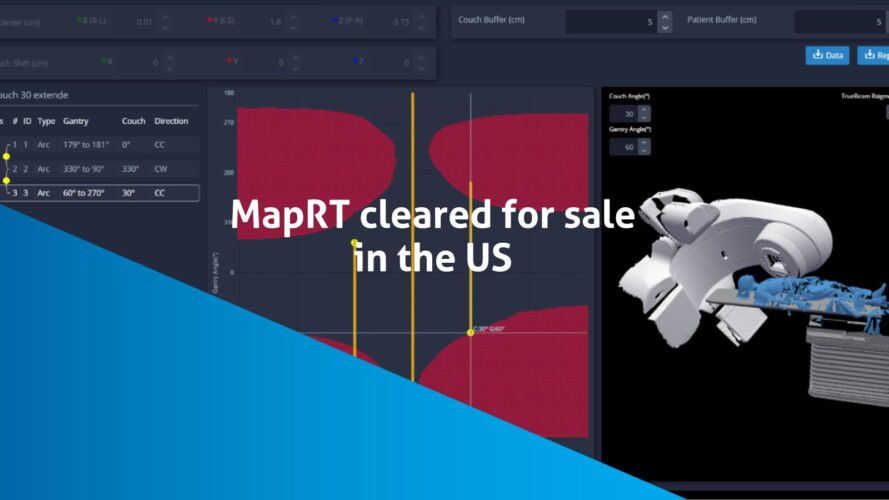MapRT cleared for sale in the US

Vision RT’s new SGRT solution to make planning noncoplanar treatments faster, easier, and safer has received clearance from the U.S. Food and Drug Administration.
MapRT was introduced at ESTRO earlier this year and is now in clinical use. It is available commercially as a beta release now, with updates planned for early 2024.
MapRT is used to check that patients are well-positioned for treatment during CT-Sim, saving valuable time in planning and treatment. It can help to improve plans by showing planners what couch and gantry angles are safe for a specific patient in their specific treatment position. MapRT can also help avoid time-intensive dry runs and urgent replanning when a collision issue is spotted on the first day of treatment.
A solution for the challenges of noncoplanar treatments:
A recent Head and Neck study found noncoplanar treatments resulted in “significantly better sparing of most organs at risk” compared to coplanar. Another study on lymphoma treatments found “a clear tendency towards higher plan quality with noncoplanar configurations.” Published models have suggested up to 2/3 reduction in complications when noncoplanar treatments are used.
Despite its benefits, some RT planners are hesitant to incorporate noncoplanar treatments into their regular practice. Noncoplanar has traditionally been seen as very resource-intensive and planners often have concerns about extra planning or machine time for dry runs and treatments.
Another common worry is that noncoplanar plans sometimes don’t reveal themselves to be undeliverable until the patient is in the treatment room, resulting in delays, replanning and increased costs.
MapRT addresses all those concerns, and even makes it possible to use longer arcs in coplanar treatments with confidence in their safety.
MapRT enables noncoplanar planning with confidence:
MapRT uses 3D cameras to image the full surface of the patient, as well as all their accessories. This surface is combined with the linac, couch surfaces and isocentre, to form a “clearance map”, which planners use to check which gantry-couch combinations are safely deliverable for the patient. This gives planners the confidence to offer personalised, noncoplanar plans, or plans with longer arcs, while ensuring there is no risk of collisions.
Helen Convery, Senior Dosimetrist (Development & Clinical Trials), who has tried out MapRT in a clinical setting, said: “We see significant value in three areas: checking patient position at CT to ensure a robust setup and avoid unnecessary dose from scans in an unusable position; enhancing planning through increasing the range of beam options; improving the use of resources and the patient experience by avoiding dry runs and delays due to last minute replans.”
With this recent FDA 510(k) approval, MapRT becomes the first-ever SGRT solution for planning, making Vision RT (the company that invented SGRT) the only provider offering SGRT for every step of the RT process: Sim (SimRT) Treatment (AlignRT, DoseRT) and now… planning.
MapRT is compatible with all treatment planning systems using DICOM RT Plan files including Eclipse™, Monaco®, Pinnacle™ and RayStation®”
RaySearch Laboratories has already developed the first deeper integration with the system and are planning to implement it clinically. This solution automates clearance checking within RayStation, showing beam clearances during the planning process.
Additional integration of automation and clearance mapping is in development and will be reported at upcoming congresses.
Thomas Carter, VP Marketing at Vision RT, said: “MapRT, through its introduction of the use of SGRT to help with planning has the potential to free up resources and make cancer treatments more predictable, while allowing clinics to deliver better patient care.”
MapRT uses exclusively licenced patents 62/128,906, 15/555,669, PCT/US2016/02023 4 and 16759347.4.

MapRT uses two lateral wide-field cameras in simulation to deliver a full 3D model of patients and accessories. This model is then used to calculate a clearance map for every couch (x-axis) and gantry (y-axis) angles. Plans can then be imported automatically to check beams, arcs, and the transition clearance.
Get in touch
Ready to take the next step?
Vision RT’s family of SGRT solutions guide radiation therapy for better patient care at every step: Sim, Planning, Treatment and Dose. Whether you’re looking for a quote, a product demo (virtual or in-person) or just more information, please get in touch.